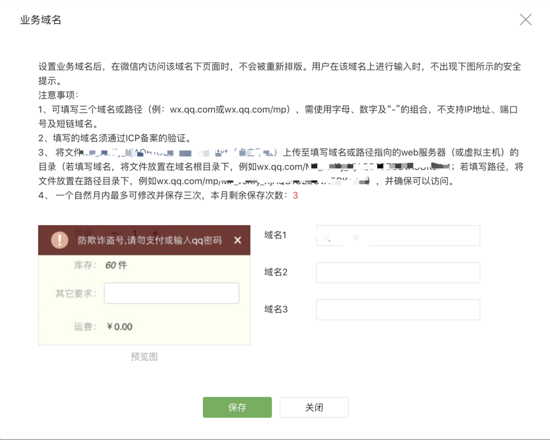您好,登錄后才能下訂單哦!
您好,登錄后才能下訂單哦!
一、準備工作
0x00 開發前準備
0x01 手動觸發dns更新

0x02 配置業務域名

0x03 將服務器請求轉發到本地
修改服務器的 /etc/ssh/sshd_config 加入 GatewayPorts yes
ssh -R 0.0.0.0:80:localhost:8080 user@server_host
二、微信網頁授權
0x01 授權流程
用戶同意授權,獲取 code
想辦法讓用戶頁面跳轉到微信的授權鏈接(比如在修飾器中進行跳轉):
def get_wx_authorize_url(appid : str, state: str = None):
if state is None:
state = "".join([random.choice(string.ascii_letters + string.digits) for _ in range(20)])
redirect_url = 'your callback url' # 回調鏈接,在這里面進行用戶信息入庫的操作
response_type = 'code'
scope = 'snsapi_userinfo'
wx_url = f"https://open.weixin.qq.com/connect/oauth3/authorize?appid={appid}&redirect_uri={redirect_url}&response_type={response_type}&scope={scope}&state={state}#wechat_redirect"
return wx_url
通過 code 換取 access_token 和 openid
def request_access_token(appid : str, secret : str, code: str):
secret = settings.WX_SECRET
api = f"https://api.weixin.qq.com/sns/oauth3/access_token?appid={appid}&secret={secret}&code=[code]&grant_type=authorization_code"
r = requests.get(api)
return r.json()
通過 access_token 換取 用戶信息
def request_userinfo(access_token: str, openid: str):
api = f"https://api.weixin.qq.com/sns/userinfo?access_token={access_token}&openid={openid}&lang=zh_CN"
r = requests.get(api)
return r.json()
用戶信息入庫
需要注意的是:微信返回的數據編碼格式為 ISO-8859-1 ,需要轉換成 utf-8 。
def convert_string_encoding(s: str, from_encoding: str, to_encoding: str) -> str: """先根據 from_encoding 轉換成bytes,然后在 decode 為 to_encoding 的字符串 """ return bytes(s, encoding=from_encoding).decode(to_encoding)
nickname = convert_string_encoding(resp['nickname'], 'ISO-8859-1', 'utf-8')
跳轉回原來訪問的鏈接
我的實現方式是在數據庫保存一條記錄,以 state 為 key 。
from app.models import WXUser, RedirectUrl
from utils import get_wx_authorize_url, get_random_string
from django.shortcuts import redirect
def login_required(func):
def wrapper(request, *args, **kwargs):
openid = request.openid
try:
user = WXUser.objects.get(openid=openid)
request.wxuser = user
except WXUser.DoesNotExist:
state = get_random_string()
redirect_url = get_wx_authorize_url(state=state)
# 存儲跳轉鏈接
try:
r = RedirectUrl.objects.get(state=state)
except RedirectUrl.DoesNotExist:
r = RedirectUrl()
r.state = state
origin_url = request.get_raw_uri()
r.url = origin_url
r.save()
return redirect(redirect_url)
return func(request, *args, **kwargs)
return wrapper
然后在我們設置的回調接口(會帶上 code 和 state )里面,就可以通過 state 從數據庫里獲取原鏈接。
class RedirectUrl(BaseModel): state = models.TextField(unique=True) url = models.TextField()
0x02 中間件
這個中間件使用 jwt 作為認證手段,為什么不使用 session ,那可以講另一個故事了,這里不贅述了。
從 HTTP_AUTHORIZATION (請求頭中的 Authorization 字段)或者 key 為 jwttoken 的 cookie 中抽取出 jwt token ,從中解析出 openid ,添加到 request 變量中,之后就可以在后續的 views里面通過 request.openid 直接獲取 openid 了。
def jwt_decode(token: Union[str, bytes]) -> tuple:
"""
:param token : 可以是 bytes 也可以是 str,如果是 str,會先 encode 轉成 bytes
:return: 第一個參數為 payload,第二個參數為異常類型
"""
if isinstance(token, str):
token = token.encode()
secret = settings.JWT_SECRET
try:
return jwt.decode(token, secret, algorithms=["HS256"]), None
except Exception as e:
# 統一捕捉異常:
# jwt.exceptions.DecodeError
# jwt.exceptions.InvalidSignatureError
# jwt.exceptions.ExpiredSignatureError
return None, e
class JWTAuthMiddleware(object):
"""
小程序認證中間件
"""
def __init__(self, get_response=None):
self.get_response = get_response
def __call__(self, request, *args, **kws):
token = self.get_authorization_header(request)
payload, error = jwt_decode(token)
if not error:
openid = payload['openid']
request.openid = openid
else:
request.openid = None
response = self.get_response(request, *args, **kws)
return response
def get_authorization_header(self, request):
"""
從 AUTHORIZATION 請求頭或者cookie 中獲取 jwt code
cookie 的 jwt code 的 key 為 jwtcode
:param request:
:return: rawtoken
"""
auth_header = request.META.get('HTTP_AUTHORIZATION', '')
cookie = request.COOKIES
rawtoken = None
if auth_header != "":
try:
rawtoken = auth_header.split(" ")[1]
except IndexError as e:
pass
if 'jwttoken' in cookie:
rawtoken = cookie['jwttoken']
return rawtoken
以上就是本文的全部內容,希望對大家的學習有所幫助,也希望大家多多支持億速云。
免責聲明:本站發布的內容(圖片、視頻和文字)以原創、轉載和分享為主,文章觀點不代表本網站立場,如果涉及侵權請聯系站長郵箱:is@yisu.com進行舉報,并提供相關證據,一經查實,將立刻刪除涉嫌侵權內容。